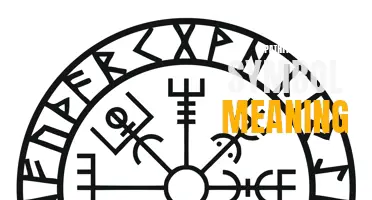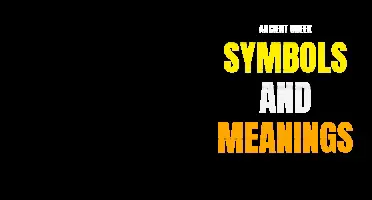
The ankh symbol is a powerful and ancient icon that has captivated the imagination of many cultures throughout history. Shrouded in mystery and mysticism, this enigmatic symbol holds deep meaning and significance in various civilizations, ranging from ancient Egypt to modern day spiritual practices. Its unique design, resembling a cross with a loop at the top, has sparked countless interpretations and theories, making it a captivating symbol that continues to fascinate and intrigue. In this article, we will delve into the rich and diverse meanings behind the ankh symbol, exploring its spiritual, cultural, and historical significance.
What You'll Learn
- What is the meaning of the ankh symbol?
- What cultural or historical significance does the ankh symbol hold?
- How is the ankh symbol used or depicted in different ancient civilizations?
- Are there any religious or spiritual connotations associated with the ankh symbol?
- In modern times, how is the ankh symbol interpreted and used?

What is the meaning of the ankh symbol?
The ankh symbol is an ancient Egyptian hieroglyphic that holds significant meaning in ancient Egyptian culture. It is often referred to as the "Key of Life" or the "Egyptian Cross." The ankh symbol resembles a looped cross with a teardrop-shaped loop at the top. It has been found in various Egyptian artworks, inscriptions, and tomb decorations dating back to the Early Dynastic Period (c. 3150–2613 BCE).
The ankh symbol has a deep spiritual meaning associated with life and eternal existence in Egyptian culture. It represents the concept of both physical and eternal life. The loop of the ankh symbolizes the eternal cycle of life, while the cross represents the physical existence on earth. The teardrop-shaped loop at the top of the ankh is often interpreted as a symbolic representation of the womb from which life originates.
The ankh symbol was closely associated with the gods and goddesses in ancient Egyptian mythology. It was often depicted in the hands of deities, indicating their power over life and death. The ankh was also carried by the gods as a symbol of their ability to bestow life upon mortals. As a result, the ankh symbol became a powerful talisman that was believed to bring health, prosperity, and protection to its wearer.
In addition to its association with the gods, the ankh symbol was also used in ceremonies and rituals related to the afterlife. It was often placed in the hands of deceased individuals or depicted on sarcophagi and tomb walls to ensure their eternal existence in the afterlife. The presence of the ankh symbol was considered essential for the deceased to maintain their vitality and continue their journey in the realm of the dead.
The ankh symbol's popularity extended beyond religious and funerary contexts. It was widely used in daily life and was frequently found in jewelry, amulets, and other personal belongings of both men and women. The ankh was worn as a protective charm and a symbol of good fortune, promoting a long and prosperous life.
Today, the ankh symbol remains a popular motif in modern Egyptian and African culture. It has become a recognized symbol of African spirituality and identity.
In summary, the ankh symbol holds immense meaning in ancient Egyptian culture. It represents the concept of life and eternal existence, symbolizing both physical and spiritual aspects of life. The ankh was closely associated with the gods, used in funerary rituals, and worn as a protective talisman. Its significance has transcended time and continues to hold cultural and spiritual relevance in modern times.
The Pyramid Symbol: Uncovering its Meaning and Significance
You may want to see also

What cultural or historical significance does the ankh symbol hold?
The ankh symbol is one of the most recognizable symbols in ancient Egyptian culture. With its distinct shape resembling a cross with a loop on top, the ankh holds deep cultural and historical significance.
In Egyptian mythology, the ankh symbolizes the key to life and is often associated with immortality and the afterlife. Its looped top represents eternal life, while the vertical line represents the path that leads to the afterlife. The ankh is often seen in the hands of gods and goddesses, representing their ability to grant and sustain life.
The ankh was also closely associated with the worship of the sun god Ra. The loop at the top of the symbol represents the sun, while the vertical line represents the rays of the sun. The ankh was often depicted being held by the gods, as a symbol of their power and connection to the sun.
In addition to its religious significance, the ankh also had a practical purpose in ancient Egyptian society. It was commonly used as an amulet or talisman, believed to offer protection and good luck to those who carried it. The ankh was often worn as a pendant or carved onto household objects, such as furniture and jewelry boxes.
The ankh symbol can also be found in numerous ancient Egyptian hieroglyphics and artworks. It is often seen in depictions of gods and pharaohs, and was used as a hieroglyphic symbol to represent the concept of life.
Today, the ankh symbol continues to hold cultural and historical significance. It has become a popular symbol in modern Egyptian and African culture, representing not only the ancient history of Egypt but also a connection to one's ancestry and heritage. The ankh is often used in contemporary art, jewelry, and tattoos as a symbol of life, power, and spirituality.
In conclusion, the ankh symbol holds great cultural and historical significance in ancient Egyptian culture. Its representation of eternal life, connection to the sun god Ra, and practical use as a talisman make it a powerful and meaningful symbol. Today, the ankh continues to be celebrated and embraced as a symbol of life and heritage.
Understanding the Symbols on POF: Unlocking the Meaning Behind the Icons
You may want to see also

How is the ankh symbol used or depicted in different ancient civilizations?
The ankh symbol, also known as the key of life or the Egyptian cross, is a symbol that dates back to ancient Egyptian civilization. However, it didn't remain exclusive to Egypt, as variations of the ankh symbol have been found in several other ancient civilizations as well. In this article, we will explore how the ankh symbol was used or depicted in different ancient civilizations, shedding light on its significance in each culture.
Ancient Egypt:
The ankh symbol holds immense significance in ancient Egyptian culture. It represents the concept of life and immortality, often being associated with the gods and goddesses of Egypt. The ankh symbol was often depicted in the hands of deities, symbolizing their power over life and death. It was also frequently associated with the goddess Isis, who was believed to have the ability to grant the gift of eternal life to the deceased.
Ancient Nubia:
Nubia, an ancient kingdom located in present-day Sudan, had close ties with ancient Egypt, which heavily influenced its culture, including the use of the ankh symbol. However, in Nubia, the ankh symbol took on a slightly different meaning. It was believed to be a symbol of fertility and was often associated with the goddess Hathor, who was worshipped for her nurturing and protective qualities.
Ancient Greece:
During the Hellenistic period, which followed the conquest of Egypt by Alexander the Great, the ankh symbol, along with other Egyptian motifs, made its way to Greece. In Greek culture, the ankh symbol was associated with life and fertility, much like in Nubia. It was often depicted being carried by Greek deities, representing their ability to bring life and abundance to the world.
Ancient Rome:
As the Roman Empire expanded, it came into contact with Egyptian culture and adopted some of its symbols, including the ankh. In Roman culture, the ankh symbol represented life, similar to its meaning in Egypt and Greece. It was often associated with the Roman goddess Venus, who was seen as the epitome of fertility and new beginnings.
Ancient Mesoamerica:
In addition to its presence in Egyptian, Nubian, Greek, and Roman cultures, the ankh symbol also appears in certain ancient Mesoamerican civilizations, such as the Mayans and the Aztecs. However, its exact meaning and significance in these cultures remain somewhat ambiguous. Some theories suggest that it represents the cycle of life and death, while others propose connections to fertility and creation.
In conclusion, the ankh symbol, with its representation of life and immortality, transcended its origins in ancient Egypt and found its way into various other ancient civilizations. While the interpretations and specific associations may vary, the prevalent use of the ankh symbol across different cultures further highlights its enduring importance as a symbol of life and vitality throughout human history.
The Meaning Behind the Triangle Symbol in Chemistry: Decoding its Significance
You may want to see also

Are there any religious or spiritual connotations associated with the ankh symbol?
The ankh is an ancient Egyptian symbol that has been associated with various religious and spiritual connotations throughout history. Also known as the key of life, the ankh consists of a looped cross with a handle at the top. It is a powerful and recognizable symbol that has endured for thousands of years.
In ancient Egypt, the ankh was considered a symbol of eternal life and immortality. It represented the concept of life and the afterlife, with the loop at the top symbolizing the eternal soul and the horizontal base representing the earthly existence. The ankh was closely associated with the gods and goddesses of ancient Egypt, particularly the sun god Ra and the goddess Isis.
The ankh was often depicted being held by gods and goddesses in ancient Egyptian art, indicating their power over life and death. It was believed that by wearing or carrying an ankh, one could connect with the divine and gain protection and blessings. It was also commonly used in burial rituals as a symbol of the life that continues in the afterlife.
In addition to its association with eternal life, the ankh also represented fertility and regeneration. The loop at the top was seen as a symbol of the womb, and the cross represented the male and female principles coming together to create new life. It was often used as a symbol of fertility in rituals and ceremonies related to marriage and childbirth.
Today, the ankh is still revered by many as a sacred and powerful symbol. It is used in various religious and spiritual practices, including Wicca, where it is often associated with female deities and the goddess. It is also popular among followers of Kemetic spirituality, which seeks to revive and honor the ancient Egyptian religious traditions.
The ankh has also been adopted by various musicians, artists, and fashion designers as a symbol of life, creativity, and individuality. It is often used as a decorative motif in jewelry, tattoos, and clothing.
Overall, the ankh is a symbol that holds deep religious and spiritual significance. It represents the interconnectedness of life and death, the eternal nature of the soul, and the power of creation and regeneration. Whether used in ancient Egyptian rituals or incorporated into modern spiritual practices, the ankh continues to inspire and empower those who connect with its meaning.
Exploring the North Star: Unveiling the Symbolic Meanings behind this Guiding Light
You may want to see also

In modern times, how is the ankh symbol interpreted and used?
In modern times, the ankh symbol continues to hold significance and is widely interpreted and used in various ways. Originating from ancient Egypt, the ankh symbol was originally associated with the Egyptian gods and the concept of eternal life. However, today it has taken on new meanings and is embraced by different cultures and individuals around the world.
One of the most common interpretations of the ankh symbol in modern times is as a representation of life and vitality. It has become a popular symbol in jewelry, clothing, and home decor, often worn or displayed as a reminder of the importance of living life fully. The loop at the top of the ankh is often seen as a depiction of the sun, which is a universal symbol of energy and life. Many people wear ankh jewelry or get tattoos of the symbol to express their belief in the power and beauty of life.
Another interpretation of the ankh symbol is as a symbol of balance and harmony. The arms of the ankh are often seen as representing the balance between feminine and masculine energy or the union of opposites. It is believed that the ankh can help bring balance and alignment to one's life, promoting a sense of peace and harmony within oneself and with the world. Many people use the ankh symbol as a meditation tool, focusing on its shape to find inner equilibrium and tranquility.
The ankh symbol is also often associated with spirituality and mystical beliefs. It is seen as a powerful talisman and a symbol of connection to a higher power or divine energy. In some spiritual practices, the ankh is believed to hold sacred and transformative energy, capable of bringing healing and spiritual awakening. It is not uncommon to see the ankh symbol incorporated in spiritual rituals, ceremonies, and sacred spaces.
Furthermore, the ankh symbol has been adopted by various subcultures and movements as a symbol of rebellion, individuality, and freedom. It has been embraced by the goth and alternative communities, often worn as a statement of personal identity and self-expression. The ankh's association with ancient Egyptian culture and its mystical connotations make it attractive to those who wish to stand out from mainstream society and embrace a unique and unconventional lifestyle.
In conclusion, the ankh symbol continues to hold significance and be interpreted and used in various ways in modern times. It represents life, vitality, balance, spirituality, and rebellion, making it a versatile and powerful symbol that resonates with individuals from different cultures and backgrounds. Whether it is worn as jewelry, displayed as art, used in meditation or embraced as a symbol of personal identity, the ankh continues to captivate and inspire people in the present day.
Exploring the Intriguing Meanings Behind Arabic Symbols
You may want to see also
Frequently asked questions
The ankh symbol is an ancient Egyptian hieroglyph that represents the concept of life. It is often depicted as a cross with a looped top, resembling a key or a sandal strap. The ankh is believed to be a powerful symbol of eternal life, fertility, prosperity, and the afterlife.
The ankh symbol originated in ancient Egypt, where it was commonly used in artwork, carvings, and jewelry. It was often associated with the gods and goddesses of Egypt, such as Osiris, Isis, and Hathor. The ankh was believed to hold magical and protective powers and was used in religious ceremonies and rituals.
The ankh symbol has different interpretations depending on the context. In addition to representing life and the afterlife, it is also associated with divine protection, immortality, and the union of male and female forces. Some interpret the looped top of the ankh as a feminine symbol, representing the goddess or the womb, while the vertical line represents the masculine or the phallus.
Yes, the ankh symbol is still used today, although primarily as a decorative motif or as a symbol of Egyptian culture and history. It is often seen in fashion, jewelry, and tattoo designs. Many people also use the ankh symbol as a personal talisman or amulet, believing it can bring them protection, fertility, and blessings.
The ankh symbol can be worn or used by anyone, regardless of their cultural or religious background. However, it does hold specific significance in Egyptian mythology and the practice of some modern pagan or esoteric systems. For these individuals, the ankh symbol may hold deeper spiritual or theological meaning associated with the gods and goddesses of ancient Egypt.







